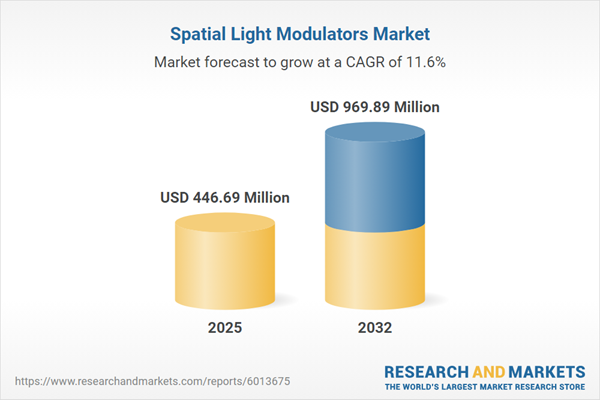Speak directly to the analyst to clarify any post sales queries you may have.
The spatial light modulators (SLMs) market is undergoing rapid evolution, driven by technological advancements and expanding into areas such as advanced photonics, quantum computing, and high-precision optical systems. Stakeholders are recalibrating product offerings and supply chain strategies in response to innovation cycles and global regulatory changes.
Market Snapshot: Spatial Light Modulators Market Size and Growth
In 2024, the global Spatial Light Modulators Market reached USD 402.31 million and is projected to rise to USD 446.69 million by 2025. Analysts anticipate continued expansion, with a compound annual growth rate (CAGR) of 11.62% pushing the market value to USD 969.89 million by 2032. Growth is attributed to strong demand from industries that require precise light modulation for display, sensing, and next-generation optical applications.
Scope & Segmentation of the Spatial Light Modulators Market
This report delivers a comprehensive assessment of evolving product ecosystems, use cases, and regional opportunities across the spatial light modulators market.
- Offering: Digital micromirror devices, liquid crystal display systems, liquid crystal on silicon solutions, polymer dispersed liquid crystal assemblies, pattern generator software, slideshow player software
- Resolution Tiers: 1080p, 4K UHD, 8K modules
- Application Segments: Automotive (LiDAR, driver assistance), communication devices, projectors, televisions, wearable technologies, confocal microscopy, fluorescence microscopy, laser surgery platforms, industrial holographic displays, optical measuring instruments, quantum communication, quantum computing
- Regional Coverage: Americas (including North and Latin America), Europe, Middle East & Africa, Asia-Pacific
- Key Companies: Hamamatsu Photonics K.K., Santec Corporation, ASML Holding N.V., Barco N.V., Holoeye Photonics AG, Jenoptik AG, KENT Optronics Inc., KOPIN Corporation, Laser 2000 (UK) Ltd., Meadowlark Optics Inc., Laser Components GmbH, PerkinElmer Inc., Swave Photonics, Texas Instruments Incorporated, Thorlabs Inc.
Key Takeaways for Senior Decision-Makers
- SLM technologies form the core of advanced displays, automotive LiDAR, and industrial imaging, positioning them as strategic assets for innovation-driven businesses.
- Liquid crystal on silicon and digital micromirror devices offer distinct pathways for achieving higher diffraction efficiency, faster response times, and adaptable form factors suited to varied end-use environments.
- Software advancements, integrating pattern generators and AI-based phase optimization, have streamlined deployment, reduced calibration complexity, and expanded the reach into areas like holography and adaptive optics.
- Collaboration between device makers, software developers, and research organizations is accelerating commercialization and translating emerging technology breakthroughs into accessible commercial products.
- Regional market dynamics and changing regulatory conditions require tailored supply chain strategies and ongoing investment in local manufacturing and R&D capacity.
Tariff Impact on the Spatial Light Modulator Supply Chain
The updated United States tariff policies have resulted in a reassessment of sourcing and production models within the spatial light modulators sector. Key optical and semiconductor components face higher production costs, leading large producers to expand nearshore manufacturing hubs and leverage domestic sourcing. Startups reliant on specialized imports are evaluating alternative supply routes and strategic alliances to address rising tariff-related expenses. Industry coalitions have started investigating new materials and manufacturing techniques to mitigate reliance on high-tariff components, encouraging further innovation in substrate and photoalignment technologies.
Methodology & Data Sources
Findings in this analysis are based on primary interviews with industry leaders and end users, supported by secondary research from academic, regulatory, and patent sources. Data triangulation ensures consistency across qualitative and quantitative inputs, while expert panels review core findings to maintain analytic rigor.
Why This Report Matters for Strategic Planning
- Enables decision-makers to anticipate shifts in high-precision optical technology adoption and adapt product strategy accordingly.
- Provides actionable insights into regulatory impacts, supply chain disruption, and opportunities for regional expansion.
- Delivers competitive intelligence for benchmarking innovation pipelines and identifying potential collaborators or acquisition targets.
Conclusion
The spatial light modulators market is adapting swiftly to evolving technology demands and supply chain realities. Informed strategy, supply resilience, and continued R&D investment will be central to success for market participants moving forward.
Additional Product Information:
- Purchase of this report includes 1 year online access with quarterly updates.
- This report can be updated on request. Please contact our Customer Experience team using the Ask a Question widget on our website.
Table of Contents
3. Executive Summary
4. Market Overview
7. Cumulative Impact of Artificial Intelligence 2025
Companies Mentioned
The companies profiled in this Spatial Light Modulators market report include:- Hamamatsu Photonics K.K.
- Santec Corporation
- ASML Holding N.V.
- Barco N.V.
- Holoeye Photonics AG
- Jenoptik AG
- KENT Optronics, Inc.
- KOPIN Corporation
- Laser 2000 (UK) Ltd.
- Meadowlark Optics, Inc.
- Laser Components GmbH
- PerkinElmer Inc.
- Swave Photonics
- Texas Instruments Incorporated
- Thorlabs, Inc.
Table Information
| Report Attribute | Details |
|---|---|
| No. of Pages | 188 |
| Published | October 2025 |
| Forecast Period | 2025 - 2032 |
| Estimated Market Value ( USD | $ 446.69 Million |
| Forecasted Market Value ( USD | $ 969.89 Million |
| Compound Annual Growth Rate | 11.6% |
| Regions Covered | Global |
| No. of Companies Mentioned | 16 |









